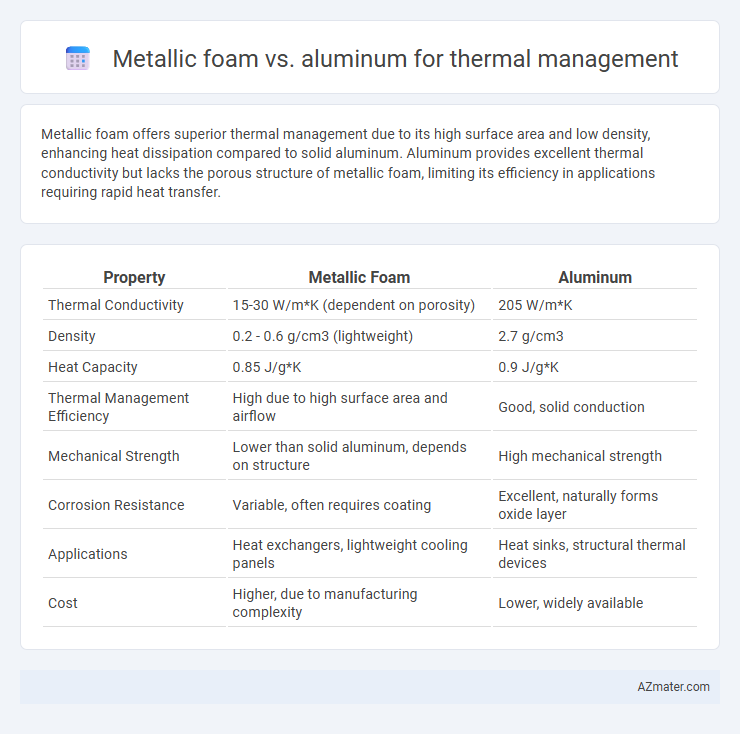Metallic foam offers superior thermal management due to its high surface area and low density, enhancing heat dissipation compared to solid aluminum. Aluminum provides excellent thermal conductivity but lacks the porous structure of metallic foam, limiting its efficiency in applications requiring rapid heat transfer.
Table of Comparison
| Property | Metallic Foam | Aluminum |
|---|---|---|
| Thermal Conductivity | 15-30 W/m*K (dependent on porosity) | 205 W/m*K |
| Density | 0.2 - 0.6 g/cm3 (lightweight) | 2.7 g/cm3 |
| Heat Capacity | 0.85 J/g*K | 0.9 J/g*K |
| Thermal Management Efficiency | High due to high surface area and airflow | Good, solid conduction |
| Mechanical Strength | Lower than solid aluminum, depends on structure | High mechanical strength |
| Corrosion Resistance | Variable, often requires coating | Excellent, naturally forms oxide layer |
| Applications | Heat exchangers, lightweight cooling panels | Heat sinks, structural thermal devices |
| Cost | Higher, due to manufacturing complexity | Lower, widely available |
Introduction to Thermal Management Challenges
Thermal management challenges in modern electronics and automotive industries demand materials with high thermal conductivity and lightweight properties. Metallic foam offers a unique combination of enhanced heat dissipation due to its porous structure and reduced weight compared to solid aluminum. Aluminum, known for its excellent thermal conductivity and mechanical strength, faces limitations in weight-sensitive applications where thermal efficiency and material economy are critical.
Properties of Metallic Foam in Heat Dissipation
Metallic foam exhibits exceptional thermal conductivity combined with a high surface area-to-volume ratio, enabling efficient heat dissipation in thermal management applications. Its porous structure facilitates enhanced convective heat transfer and reduces thermal resistance compared to solid aluminum, improving cooling performance. The lightweight nature and mechanical strength of metallic foam make it ideal for integrating into heat exchangers and electronic cooling systems where effective thermal regulation is critical.
Aluminum: Traditional Choice for Thermal Applications
Aluminum remains the traditional choice for thermal management due to its excellent thermal conductivity, lightweight nature, and corrosion resistance, making it ideal for heat sinks and exchangers. Its machinability and cost-effectiveness provide advantages over metallic foam, which, while offering unique properties like lower density and potential for improved heat dissipation through porous structures, often faces limitations in mechanical strength and manufacturing complexity. Aluminum's widespread industrial use and recyclability solidify its role as a preferred material in thermal applications across automotive, electronics, and aerospace sectors.
Structural Differences: Metallic Foam vs Aluminum
Metallic foam exhibits a porous, cellular structure with interconnected voids that significantly reduce its density while enhancing thermal insulation and energy absorption capabilities compared to solid aluminum. Aluminum, characterized by a dense, homogeneous crystalline structure, offers higher thermal conductivity but less effective heat dissipation in applications requiring lightweight materials. The structural difference results in metallic foam providing superior vibration damping and thermal shock resistance, making it ideal for advanced thermal management systems where weight and mechanical performance are critical.
Thermal Conductivity Comparison
Metallic foam, characterized by its highly porous structure, exhibits lower thermal conductivity compared to solid aluminum, influencing its heat transfer efficiency in thermal management applications. Aluminum's thermal conductivity ranges from 205 to 250 W/m*K, significantly surpassing that of metallic foams, which typically fall between 10 and 30 W/m*K depending on porosity and composition. Despite reduced conductivity, metallic foam offers enhanced surface area and convective heat transfer, making it suitable for applications requiring efficient heat dissipation with reduced weight.
Weight and Density Considerations
Metallic foam offers significantly lower density compared to solid aluminum, resulting in lighter components essential for thermal management applications where weight reduction is critical. The porous structure of metallic foam enhances thermal dissipation while maintaining structural integrity, making it advantageous over aluminum in aerospace and automotive industries. Aluminum's higher density increases overall weight but provides superior thermal conductivity for applications where mass is less of a concern.
Mechanical Strength and Durability
Metallic foam offers superior mechanical strength and durability compared to traditional aluminum due to its unique cellular structure, which provides excellent energy absorption and resistance to deformation under stress. The interconnected porosity in metallic foam enhances load distribution while maintaining lightweight properties, making it ideal for thermal management applications requiring robust mechanical performance. Aluminum, although lightweight and thermally conductive, generally exhibits lower impact resistance and durability, limiting its effectiveness in environments with high mechanical demands.
Corrosion Resistance and Longevity
Metallic foam exhibits superior corrosion resistance compared to traditional aluminum due to its porous structure, which can be coated or alloyed to enhance protective barriers against environmental degradation. Aluminum, while lightweight and efficient for thermal management, is more susceptible to oxidation and requires anodizing or other treatments to improve durability in harsh conditions. The enhanced longevity of metallic foam in thermal management applications results from its combined corrosion resistance and structural integrity under prolonged thermal cycling.
Cost-Effectiveness and Manufacturing Feasibility
Metallic foam offers superior thermal management due to its high surface area and low density, enhancing heat dissipation while reducing material usage, which can lower overall costs compared to solid aluminum. Manufacturing feasibility is improved by metallic foam's compatibility with various fabrication techniques like casting and additive manufacturing, enabling complex geometries that optimize cooling performance and reduce machining expenses. Aluminum remains cost-effective for simple designs with established manufacturing processes, but metallic foam provides a strategic advantage in applications requiring lightweight structures and enhanced thermal conductivity at competitive production costs.
Ideal Applications: Choosing Metallic Foam or Aluminum
Metallic foam excels in thermal management applications requiring high surface area and lightweight structures, such as heat exchangers in aerospace and automotive industries where rapid heat dissipation and weight reduction are critical. Aluminum remains ideal for applications demanding high thermal conductivity and structural strength, including electronics cooling systems and heat sinks for consumer electronics. Selecting between metallic foam and aluminum depends on balancing factors like heat transfer efficiency, mechanical stress tolerance, and weight constraints specific to the intended application.

Infographic: Metallic foam vs Aluminum for Thermal management
 azmater.com
azmater.com